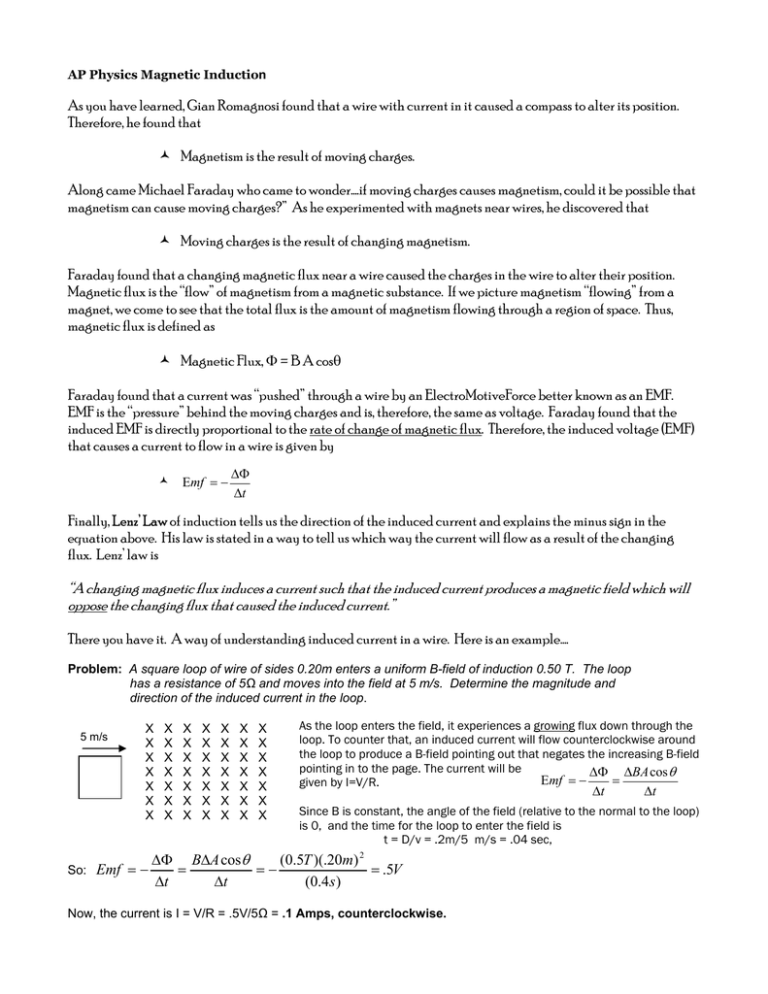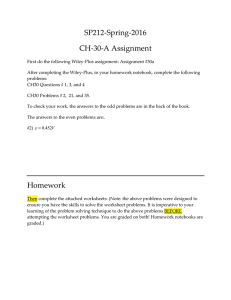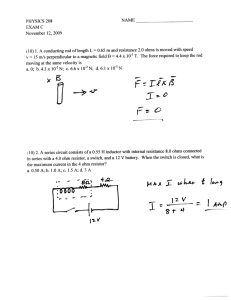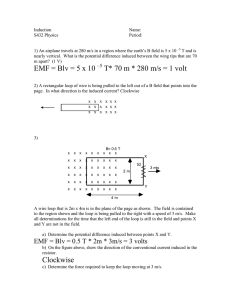AP Physics
advertisement

AP Physics Magnetic Induction As you have learned, Gian Romagnosi found that a wire with current in it caused a compass to alter its position. Therefore, he found that Magnetism is the result of moving charges. Along came Michael Faraday who came to wonder….if moving charges causes magnetism, could it be possible that magnetism can cause moving charges?” As he experimented with magnets near wires, he discovered that Moving charges is the result of changing magnetism. Faraday found that a changing magnetic flux near a wire caused the charges in the wire to alter their position. Magnetic flux is the “flow” of magnetism from a magnetic substance. If we picture magnetism “flowing” from a magnet, we come to see that the total flux is the amount of magnetism flowing through a region of space. Thus, magnetic flux is defined as Magnetic Flux, Φ = B A cosθ Faraday found that a current was “pushed” through a wire by an ElectroMotiveForce better known as an EMF. EMF is the “pressure” behind the moving charges and is, therefore, the same as voltage. Faraday found that the induced EMF is directly proportional to the rate of change of magnetic flux. Therefore, the induced voltage (EMF) that causes a current to flow in a wire is given by Εmf = − ∆Φ ∆t Finally, Lenz’ Law of induction tells us the direction of the induced current and explains the minus sign in the equation above. His law is stated in a way to tell us which way the current will flow as a result of the changing flux. Lenz’ law is “A changing magnetic flux induces a current such that the induced current produces a magnetic field which will oppose the changing flux that caused the induced current.” There you have it. A way of understanding induced current in a wire. Here is an example…. Problem: A square loop of wire of sides 0.20m enters a uniform B-field of induction 0.50 T. The loop has a resistance of 5Ω and moves into the field at 5 m/s. Determine the magnitude and direction of the induced current in the loop. 5 m/s So: X X X X X X X Emf = − X X X X X X X X X X X X X X X X X X X X X X X X X X X X X X X X X X X X X X X X X X As the loop enters the field, it experiences a growing flux down through the loop. To counter that, an induced current will flow counterclockwise around the loop to produce a B-field pointing out that negates the increasing B-field pointing in to the page. The current will be ∆Φ ∆BA cos θ Εmf = − = given by I=V/R. ∆t ∆t Since B is constant, the angle of the field (relative to the normal to the loop) is 0, and the time for the loop to enter the field is t = D/v = .2m/5 m/s = .04 sec, (0.5T )(.20m) 2 ∆Φ B∆A cosθ =− = .5V = ∆t (0.4s ) ∆t Now, the current is I = V/R = .5V/5Ω = .1 Amps, counterclockwise. Some Sample problems using Lenz’ Law: 1. A constant magnetic field exists in a region where a loop of wire is being pulled out of the region. In what direction is the induced current in the loop? • • • • • • • • • • • • • • • • • • • • 2. In the diagram, an electromagnet with current flowing in the loops, as shown, is being pulled away from the circular hoop on the left. Will the current flow down the front side of the hoop or up? Explain. 3. A loop of wire is held fixed in a magnetic field that points into the page as shown. If the field begins to decrease, which direction will be the induced current in the loop? X X X X X X X 4. X X X X X X X X X X X X X X X X X X X X X X X X X X X X X X X X X X X X X X X X X X A piece of flexible wire is held in a magnetic field. The wire is grabbed at points A and B and stretched outward to elongate the loop. What direction is the induced current in the loop? • • • • • • • 5. • • • •A • • • • • • • • • • • • • • • • • • • • • • • • • • • • • • • • • • B • • • • A square section of wire has a magnetic field passing up through it and is initially perpendicular to the plane of the loop. As the loop is turned, what direction is the induced current in the front section of the wire loop?






